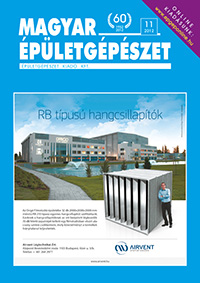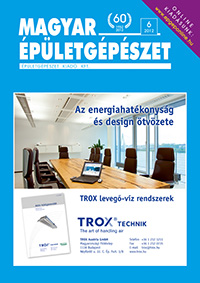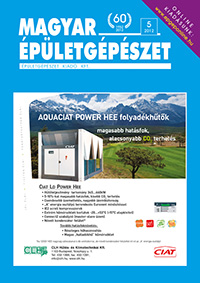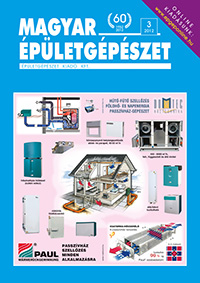Lapszámok

2012 10. szám
- Dr. Garbai László - Dr. Jasper Andor PhD:
A külső hőmérsékletek tartamdiagramjának matematikai leírása - Erhorn, Hans - Erhorn-Kluttig, Heike:
The Path towards 2020: Nearly Zero-Energy Buildings - Dr. Csoknyai Tamás PhD - Dr. Talamon Attila - Dr. Csoknyai István - Dr. Zöld András:
„H”-ból „C”, „F”-ből „A”: Az épületenergetikai rendelet módosításának hatása a távfűtéses épületek energetikai besorolására - Dr. Safa’a, Al-Hilal:
A napenergia hasznosítása az épülettervezésben - EXPO-INOX Hungary Kft.:
A flexibilis, acél égéstermék-elvezető rendszerek megítélése - Erdey Zsolt - Kovács Miklós:
A háztartási gázmérők távleolvasó rendszere az Égáz-Dégáz Földgázelosztó Zrt.-nél - Meszléry Celesztin:
Természetes szellőztetés – visszatérés a gyökerekhez - TOSHIBA AIR-COND:
Budapesten ülésezett az európai Toshiba Konferencia - Gáti Tamás:
EASYBUS tűzvédelmi és légtechnikai vezérlő rendszer - Kovács István:
A hővisszanyerős lakásszellőztető rendszerek higiéniája - Air Trade Centre Hungary Kft.:
GTDHR(V) – Magas hatásfokú hővisszanyerő egységek - Rébay Lajos:
Tanulságos életpályák – Takács Gábor - Szabó Balázs:
Titokzatos bunker Budapest szíve alatt – F-4. 2. rész
Hozzászólások
The Path towards 2020: Nearly Zero-Energy Buildings
Még nem érkezett hozzászólás!
Erhorn, Hans - Erhorn-Kluttig, Heike
The Path towards 2020: Nearly Zero-Energy Buildings
Az Épületenergetikai Irányelv átdolgozásának 9. fejezete megköveteli a tagállamoktól, hogy 2020. december 31. után valamennyi új épület, valamint 2018. december 31. után valamennyi közforgalmú új épület közel zéró energiafogyasztású épület (NZEB) legyen. Az Irányelv 2. fejezete meghatározza a közel zéró energiafogyasztású épület definícióját. A tagállamok feladata, hogy nemzeti intézkedéseket tegyenek az előírás megvalósítása érdekében.
A szerzők megvizsgálják az épületek energiafelhasználásának alakulását Németországban, és azoknak az intézkedéseknek a hatását, amelyeket ott az elmúlt 35 évben tettek. Ugyancsak bemutatják azokat az intézkedéseket, amelyeket Dániában hoznak a közel zéró energiafogyasztás elérése érdekében. Felsorolják, hogy melyek azok a kérdések, amelyeket a jövőben még elemezni kell.
The recast of the Energy Performance of Buildings Directive, in Article 9, requires Member States to ensure that by 31 December 2020, all new buildings are nearly zero-energy buildings (NZEB) and after 31 December 2018, new buildings occupied and owned by public authorities are nearly zero-energy buildings. Member States shall draw up national plans for increasing the number of nearly zeroenergy buildings and shall develop policies and take measures to stimulate the transformation of buildings that are refurbished into nearly zero-energy buildings.
Article 2 of the EPBD defines a nearly zero-energy building to be a building with a very high energy performance. The nearly zero or very low amount of energy required should be covered to a very significant extent by energy from renewable sources produced on-site or nearby.
The Member States are responsible for the practical application of the definition stated in Article 2 and have to document this in their national plans.
The Concerted Action EPBD offers all EU Member States a platform for the exchange and discussion of national approaches, as well as of the challenges the countries face at defining the national application. Also policies and incentives to increase the number of NZEBs and ways to transform existing buildings into NZEBs are analysed in terms of their potential impact.










